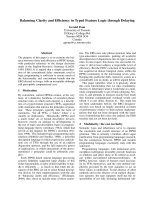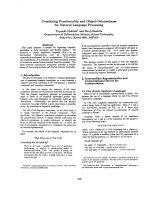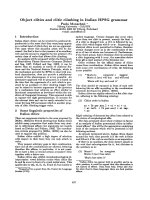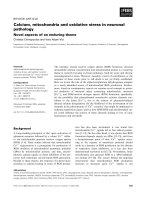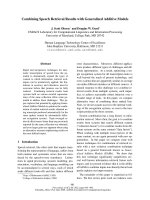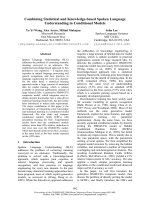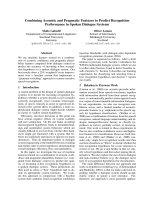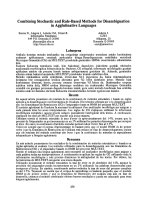Báo cáo khoa học: "Combining Deep and Shallow Approaches in Parsing German" pptx
Bạn đang xem bản rút gọn của tài liệu. Xem và tải ngay bản đầy đủ của tài liệu tại đây (85.57 KB, 8 trang )
Combining Deep and Shallow Approaches in Parsing German
Michael Schiehlen
Institute for Computational Linguistics, University of Stuttgart,
Azenbergstr. 12, D-70174 Stuttgart
Abstract
The paper describes two parsing schemes:
a shallow approach based on machine
learning and a cascaded finite-state parser
with a hand-crafted grammar. It dis-
cusses several ways to combine them and
presents evaluation results for the two in-
dividual approaches and their combina-
tion. An underspecification scheme for
the output of the finite-state parser is intro-
duced and shown to improve performance.
1 Introduction
In several areas of Natural Language Processing, a
combination of different approaches has been found
to give the best results. It is especially rewarding to
combine deep and shallow systems, where the for-
mer guarantees interpretability and high precision
and the latter provides robustness and high recall.
This paper investigates such a combination consist-
ing of an n-gram based shallow parser and a cas-
caded finite-state parser
1
with hand-crafted gram-
mar and morphological checking. The respective
strengths and weaknesses of these approaches are
brought to light in an in-depth evaluation on a tree-
bank of German newspaper texts (Skut et al., 1997)
containing ca. 340,000 tokens in 19,546 sentences.
The evaluation format chosen (dependency tuples)
is used as the common denominator of the systems
1
Although not everyone would agree that finite-state
parsers constitute a ‘deep’ approach to parsing, they still are
knowledge-based, require efforts of grammar-writing, a com-
plex linguistic lexicon, manage without training data, etc.
in building a hybrid parser with improved perfor-
mance. An underspecification scheme allows the
finite-state parser partially ambiguous output. It is
shown that the other parser can in most cases suc-
cessfully disambiguate such information.
Section 2 discusses the evaluation format adopted
(dependency structures), its advantages, but also
some of its controversial points. Section 3 formu-
lates a classification problem on the basis of the
evaluation format and applies a machine learner to
it. Section 4 describes the architecture of the cas-
caded finite-state parser and its output in a novel
underspecification format. Section 5 explores sev-
eral combination strategies and tests them on several
variants of the two base components. Section 6 pro-
vides an in-depth evaluation of the component sys-
tems and the hybrid parser. Section 7 concludes.
2 Parser Evaluation
The simplest method to evaluate a parser is to count
the parse trees it gets correct. This measure is, how-
ever, not very informative since most applications do
not require one hundred percent correct parse trees.
Thus, an important question in parser evaluation is
how to break down parsing results.
In the PARSEVAL evaluation scheme (Black et
al., 1991), partially correct parses are gauged by the
number of nodes they produce and have in com-
mon with the gold standard (measured in precision
and recall). Another figure (crossing brackets) only
counts those incorrect nodes that change the partial
order induced by the tree. A problematic aspect of
the PARSEVAL approach is that the weight given to
particular constructions is again grammar-specific,
since some grammars may need more nodes to de-
scribe them than others. Further, the approach does
not pay sufficient heed to the fact that parsing de-
cisions are often intricately twisted: One wrong de-
cision may produce a whole series of other wrong
decisions.
Both these problems are circumvented when
parsing results are evaluated on a more abstract
level, viz. dependency structure (Lin, 1995).
Dependency structure generally follows predicate-
argument structure, but departs from it in that the
basic building blocks are words rather than predi-
cates. In terms of parser evaluation, the first property
guarantees independence of decisions (every link is
relevant also for the interpretation level), while the
second property makes for a better empirical justifi-
cation. for evaluation units. Dependency structure
can be modelled by a directed acylic graph, with
word tokens at the nodes. In labelled dependency
structure, the links are furthermore classified into a
certain set of grammatical roles.
Dependency can be easily determined from con-
stituent structure if in every phrase structure rule
a constituent is singled out as the head (Gaifman,
1965). To derive a labelled dependency structure, all
non-head constituents in a rule must be labelled with
the grammatical role that links their head tokens to
the head token of the head constituent.
There are two cases where the divergence be-
tween predicates and word tokens makes trouble: (1)
predicates expressed by more than one token, and
(2) predicates expressed by no token (as they occur
in ellipsis). Case 1 frequently occurs within the verb
complex (of both English and German). The solu-
tion proposed in the literature (Black et al., 1991;
Lin, 1995; Carroll et al., 1998; Kübler and Telljo-
hann, 2002) is to define a normal form for depen-
dency structure, where every adjunct or argument
attaches to some distinguished part of the verb com-
plex. The underlying assumption is that those cases
where scope decisions in the verb complex are se-
mantically relevant (e.g. with modal verbs) are not
resolvable in syntax anyway. There is no generally
accepted solution for case 2 (ellipsis). Most authors
in the evaluation literature neglect it, perhaps due
to its infrequency (in the NEGRA corpus, ellipsis
only occurs in 1.2% of all dependency relations).
Robinson (1970, 280) proposes to promote one of
the dependents (preferably an obligatory one) (1a)
or even all dependents (1b) to head status.
(1) a. the very brave
b. John likes tea and Harry coffee.
A more sweeping solution to these problems is to
abandon dependency structure at all and directly
go for predicate-argument structure (Carroll et al.,
1998). But as we argued above, moving to a
more theoretical level is detrimental to comparabil-
ity across grammatical frameworks.
3 A Direct Approach: Learning
Dependency Structure
According to the dependency structure approach to
evaluation, the task of the parser is to find the cor-
rect dependency structure for a string, i.e. to as-
sociate every word token with pairs of head token
and grammatical role or else to designate it as inde-
pendent. To make the learning task easier, the num-
ber of classes should be reduced as much as possi-
ble. For one, the task could be simplified by focus-
ing on unlabelled dependency structure (measured
in “unlabelled” precision and recall (Eisner, 1996;
Lin, 1995)), which is, however, in general not suffi-
cient for further semantic processing.
3.1 Tree Property
Another possibility for reduction is to associate ev-
ery word with at most one pair of head token and
grammatical role, i.e. to only look at dependency
trees rather than graphs. There is one case where
the tree property cannot easily be maintained: co-
ordination. Conceptually, all the conjuncts are head
constituents in coordination, since the conjunction
could be missing, and selectional restrictions work
on the individual conjuncts (2).
(2) John ate (fish and chips|*wish and ships).
But if another word depends on the conjoined heads
(see (4a)), the tree property is violated. A way out
of the dilemma is to select a specific conjunct as
modification site (Lin, 1995; Kübler and Telljohann,
2002). But unless care is taken, semantically vi-
tal information is lost in the process: Example (4)
shows two readings which should be distinguished
in dependency structure. A comparison of the two
readings shows that if either the first conjunct or
the last conjunct is unconditionally selected certain
readings become undistinguishable. Rather, in or-
der to distinguish a maximum number of readings,
pre-modifiers must attach to the last conjunct and
post-modifiers and coordinating conjunctions to the
first conjunct
2
. The fact that the modifier refers to
a conjunction rather than to the conjunct is recorded
in the grammatical role (by adding c to it).
(4) a.
the [fans and supporters] of Arsenal
b.
[the fans] and [supporters of Arsenal]
Other constructions contradicting the tree property
are arguably better treated in the lexicon anyway
(e.g. control verbs (Carroll et al., 1998)) or could
be solved by enriching the repertory of grammati-
cal roles (e.g. relative clauses with null relative pro-
nouns could be treated by adding the dependency re-
lation between head verb and missing element to the
one between head verb and modified noun).
In a number of linguistic phenomena, dependency
theorists disagree on which constituent should be
chosen as the head. A case in point are PPs. Few
grammars distinguish between adjunct and subcate-
gorized PPs at the level of prepositions. In predicate-
argument structure, however, the embedded NP is
in one case related to the preposition, in the other
to the subcategorizing verb. Accordingly, some ap-
proaches take the preposition to be the head of a PP
(Robinson, 1970; Lin, 1995), others the NP (Kübler
and Telljohann, 2002). Still other approaches (Tes-
nière, 1959; Carroll et al., 1998) conflate verb,
preposition and head noun into a triple, and thus
only count content words in the evaluation. For
learning, the matter can be resolved empirically:
2
Even in this setting some readings cannot be distinguished
(see e.g. (3) where a conjunction of three modifiers would
be retrieved). Nevertheless, the proposed scheme fails in only
0.0017% of all dependency tuples.
(3)
In New York, we never meet, but in Boston.
Note that by this move we favor interpretability over projectiv-
ity, but example (4a) is non-projective from the start.
Taking prepositions as the head somewhat improves
performance, so we took PPs to be headed by prepo-
sitions.
3.2 Encoding Head Tokens
Another question is how to encode the head to-
ken. The simplest method, encoding the word by its
string position, generates a large space of classes. A
more efficient approach uses the distance in string
position between dependent and head token. Finally,
Lin (1995) proposes a third type of representation:
In his work, a head is described by its word type, an
indication of the direction from the dependent (left
or right) and the number of tokens of the same type
that lie between head and dependent. An illustrative
representation would be »paper which refers to the
second nearest token
paper
to the right of the cur-
rent token. Obviously there are far too many word
tokens, but we can use Part-Of-Speech tags instead.
Furthermore information on inflection and type of
noun (proper versus common nouns) is irrelevant,
which cuts down the size even more. We will call
this approach nth-tag. A further refinement of the
nth-tag approach makes use of the fact that depen-
dency structures are acylic. Hence, only those words
with the same POS tag as the head between depen-
dent and head must be counted that do not depend
directly or indirectly on the dependent. We will call
this approach covered-nth-tag.
pos dist nth-tag cover
labelled 1,924 1,349 982 921
unlabelled 97 119 162 157
Figure 1: Number of Classes in NEGRA Treebank
Figure 1 shows the number of classes the individ-
ual approaches generate on the NEGRA Treebank.
Note that the longest sentence has 115 tokens (with
punctuation marks) but that punctuation marks do
not enter dependency structure. The original tree-
bank exhibits 31 non-head syntactic
3
grammatical
roles. We added three roles for marker comple-
ments (CMP), specifiers (SPR), and floating quanti-
fiers (NK+), and subtracted the roles for conjunction
markers (CP) and coreference with expletive (RE).
3
i.e. grammatical roles not merely used for tokenization
22 roles were copied to mark reference to conjunc-
tion. Thus, all in all there was a stock of 54 gram-
matical roles.
3.3 Experiments
We used -grams (3-grams and 5-grams) of POS
tags as context and C4.5 (Quinlan, 1993) for ma-
chine learning. All results were subjected to 10-fold
cross validation.
The learning algorithm always returns a result.
We counted a result as not assigned, however, if it
referred to a head token outside the sentence. See
Figure 2 for results
4
of the learner. The left column
shows performance with POS tags from the treebank
(ideal tags, I-tags), the right column values obtained
with POS tags as generated automatically by a tag-
ger with an accuracy of 95% (tagger tags, T-tags).
I-tags T-tags
F-val prec rec F-val prec rec
dist, 3 .6071 .6222 .5928 .5902 .6045 .5765
dist, 5 .6798 .6973 .6632 .6587 .6758 .6426
nth-tag, 3 .7235 .7645 .6866 .6965 .7364 .6607
nth-tag, 5 .7716 .7961 .7486 .7440 .7682 .7213
cover, 3 .7271 .7679 .6905 .7009 .7406 .6652
cover, 5 .7753 .7992 .7528 .7487 .7724 .7264
Figure 2: Results for C4.5
The nth-tag head representation outperforms the
distance representation by 10%. Considering
acyclicity (cover) slightly improves performance,
but the gain is not statistically significant (t-test with
99%). The results are quite impressive as they stand,
in particular the nth-tag 5-gram version seems to
achieve quite good results. It should, however, be
stressed that most of the dependencies correctly de-
termined by the n-gram methods extend over no
more than 3 tokens. With the distance method, such
‘short’ dependencies make up 98.90% of all depen-
dencies correctly found, with the nth-tag method
still 82%, but only 79.63% with the finite-state
parser (see section 4) and 78.91% in the treebank.
4
If the learner was given a chance to correct its errors, i.e.
if it could train on its training results in a second round, there
was a statistically significant gain in F-value with recall rising
and precision falling (e.g. F-value .7314, precision .7397, recall
.7232 for nth-tag trigrams, and F-value .7763, precision .7826,
recall .7700 for nth-tag 5-grams).
4 Cascaded Finite-State Parser
In addition to the learning approach, we used a cas-
caded finite-state parser (Schiehlen, 2003), to extract
dependency structures from the text. The layout
of this parser is similar to Abney’s parser (Abney,
1991): First, a series of transducers extracts noun
chunks on the basis of tokenized and POS-tagged
text. Since center-embedding is frequent in German
noun phrases, the same transducer is used several
times over. It also has access to inflectional informa-
tion which is vital for checking agreement and deter-
mining case for subsequent phases (see (Schiehlen,
2002) for a more thorough description). Second, a
series of transducers extracts verb-final, verb-first,
and verb-second clauses. In contrast to Abney, these
are full clauses, not just simplex clause chunks, so
that again recursion can occur. Third, the result-
ing parse tree is refined and decorated with gram-
matical roles, using non-deterministic ‘interpreta-
tion’ transducers (the same technique is used by
Abney (1991)). Fourth, verb complexes are exam-
ined to find the head verb and auxiliary passive or
raising verbs. Only then subcategorization frames
can be checked on the clause elements via a non-
deterministic transducer, giving them more specific
grammatical roles if successful. Fifth, dependency
tuples are extracted from the parse tree.
4.1 Underspecification
Some parsing decisions are known to be not resolv-
able by grammar. Such decisions are best handed
over to subsequent modules equipped with the rel-
evant knowledge. Thus, in chart parsing, an under-
specified representation is constructed, from which
all possible analyses can be easily and efficiently
read off. Elworthy et al. (2001) describe a cascaded
parser which underspecifies PPattachment by allow-
ing modifiers to be linked to several heads in a de-
pendency tree. Example (5) illustrates this scheme.
(5)
I saw a man in a car on the hill.
The main drawback of this scheme is its overgener-
ation. In fact, it allows six readings for example (5),
which only has five readings (the speaker could not
have been in the car, if the man was asserted to be
on the hill). A similar clause with 10 PPs at the
end would receive 39,916,800 readings rather than
58,786. So a more elaborate scheme is called for,
but one that is just as easy to generate.
A device that often comes in handy for under-
specification are context variables (Maxwell III and
Kaplan, 1989; Dörre, 1997). First let us give every
sequence of prepositional phrases in every clause a
specific name (e.g. 1B for the second sequence in
the first clause). Now we generate the ambiguous
dependency relations (like (Elworthy et al., 2001))
but label them with context variables. Such context
variables consist of the sequence name , a num-
ber designating the dependent in left-to-right or-
der (e.g. 0 for
in
, 1 for
on
in example (5)), and a
number designating the head in left-to-right (e.g.
0 for
saw
, 1 for
man
, 2 for
hill
in (5)). If the links
are stored with the dependents, the number can be
left implicit. Generation of such a representation is
straightforward and, in particular, does not lead to a
higher class of complexity of the full system. Ex-
ample (6) shows a tuple representation for the two
prepositions of sentence (5).
(6) in [1A00] saw ADJ, [1A01] man ADJ
on [1A10] saw ADJ, [1A11] man ADJ,
[1A12] car ADJ
In general, a dependent
can modify heads,
viz. the heads numbered . Now we
put the following constraint on resolution: A depen-
dent can only modify a head if no previous
dependent which could have attached to (i.e.
) chose some head to the left of
rather than . The condition is formally expressed
in (7). In example (6) there are only two dependents
(
in
,
on
). If
in
attaches to
saw
,
on
cannot
attach to a head between
saw
and
in
; conversely if
on
attaches to
man
,
in
cannot attach to a head before
man
. Nothing follows if
on
attaches to
car
.
(7) Constraint:
for all PP sequences
The cascaded parser described adopts this under-
specification scheme for right modification. Left
modification (see (8)) is usually not stacked so the
simpler scheme of Elworthy et al. (2001) suffices.
(8) They are usually competent people.
German is a free word order language, so that sub-
categorization can be ambiguous. Such ambiguities
should also be underspecified. Again we introduce a
context variable for every ambiguous subcatego-
rization frame (e.g. 1 in (9)) and count the individual
readings
(with letters a,b in (9)).
(9) Peter kennt Karl. (Peter knows Karl / Karl
knows Peter.)
Peter kennt [1a] SBJ/[1b] OA
kennt TOP
Karl kennt [1a] OA/[1b] SBJ
Since subcategorization ambiguity interacts with at-
tachment ambiguity, context variables sometimes
need to be coupled: In example (10) the attachment
ambiguity only occurs if the PP is read as adjunct.
(10) Karl fügte einige Gedanken zu dem Werk
hinzu. (Karl added some thoughts on/to the
work.)
Gedanken fügte [1a] OA/[1b] OA
zu [1A0] fügte [1a] PP:zu/[1b] ADJ
[1A1] Gedanken PP:zu
1A1 < 1b
4.2 Evaluation of the Underspecified
Representation
In evaluating underspecified representations,
Riezler et al. (2002) distinguish upper and lower
bound, standing for optimal performance in disam-
biguation and average performance, respectively. In
I-tags T-tags
F-val prec rec F-val prec rec
upper .8816 .9137 .8517 .8377 .8910 .7903
direct .8471 .8779 .8183 .8073 .8588 .7617
lower .8266 .8567 .7986 .7895 .8398 .7449
Figure 3: Results for Cascaded Parser
Figure 3, values are also given for the performance
of the parser without underspecification, i.e. always
favoring maximal attachment and word order with-
out scrambling (direct). Interestingly this method
performs significantly better than average, an effect
mainly due to the preference for high attachment.
5 Combining the Parsers
We considered several strategies to combine the re-
sults of the diverse parsing approaches: simple vot-
ing, weighted voting, Bayesian learning, Maximum
Entropy, and greedy optimization of F-value.
Simple Voting. The result predicted by the ma-
jority of base classifiers is chosen. The finite-state
parser, which may give more than one result, dis-
tributes its vote evenly on the possible readings.
Weighted Voting. In weighted voting, the result
which gets the most votes is chosen, where the num-
ber of votes given to a base classifier is correlated
with its performance on a training set.
Bayesian Learning. The Bayesian approach of
Xu et al. (1992) chooses the most probable predic-
tion. The probability of a prediction is computed
by the product
of the probability of
given the predictions made by the individual base
classifiers . The probability of a correct
prediction given a learned prediction is ap-
proximated by relative frequency in a training set.
Maximum Entropy. Combining the results can
also be seen as a classification task, with base pre-
dictions added to the original set of features. We
used the Maximum Entropy approach
5
(Berger et
al., 1996) as a machine learner for this task. Un-
derspecified features were assigned multiple values.
Greedy Optimization of F-value. Another
method uses a decision list of prediction–classifier
pairs to choose a prediction by a classifier. The list
is obtained by greedy optimization: In each step,
the prediction–classifier pair whose addition results
in the highest gain in F-value for the combined
model on the training set is appended to the list.
The algorithm terminates when F-value cannot be
improved by any of the remaining candidates. A
finer distinction is possible if the decision is made
dependent on the POS tag as well. For greedy
optimization, the predictions of the finite-state
parser were classified only in grammatical roles, not
head positions. We used 10-fold cross validation to
determine the decision lists.
5
More specifically, the OpenNLP implementation
( was used with 10 iterations
and a cut-off frequency for features of 10.
F-val prec rec
simple voting .7927 .8570 .7373
weighted voting .8113 .8177 .8050
Bayesian learning .8463 .8509 .8417
Maximum entropy .8594 .8653 .8537
greedy optim .8795 .8878 .8715
greedy optim+tag .8849 .8957 .8743
Figure 4: Combination Strategies
We tested the various combination strategies for
the combination Finite-State parser (lower bound)
and C4.5 5-gram nth-tag on ideal tags (results in Fig-
ure 4). Both simple and weighted voting degrade
the results of the base classifiers. Greedy optimiza-
tion outperforms all other strategies. Indeed it comes
near the best possible choice which would give an
F-score of .9089 for 5-gram nth-tag and finite-state
parser (upper bound) (cf. Figure 5).
without POS tag with POS tag
I-tags F-val prec rec F-val prec rec
upp, nth 5 .9008 .9060 .8956 .9068 .9157 .8980
low, nth 5 .8795 .8878 .8715 .8849 .8957 .8743
low, dist 5 .8730 .8973 .8499 .8841 .9083 .8612
low, nth 3 .8722 .8833 .8613 .8773 .8906 .8644
low, dist 3 .8640 .9034 .8279 .8738 .9094 .8410
dir, nth 5 .8554 .8626 .8483 .8745 .8839 .8653
Figure 5: Combinations via Optimization
Figure 5 shows results for some combinations
with the greedy optimization strategy on ideal tags.
All combinations listed yield an improvement of
more than 1% in F-value over the base classifiers.
It is striking that combination with a shallow parser
does not help the Finite-State parser much in cov-
erage (upper bound), but that it helps both in dis-
ambiguation (pushing up the lower bound to almost
the level of upper bound) and robustness (remedy-
ing at least some of the errors). The benefit of un-
derspecification is visible when lower bound and di-
rect are compared. The nth-tag 5-gram method was
the best method to combine the finite-state parser
with. Even on T-tags, this combination achieved an
F-score of .8520 (lower, upper: .8579, direct: .8329)
without POS tag and an F-score of .8563 (lower, up-
per: .8642, direct: .8535) with POS tags.
6 In-Depth Evaluation
Figure 6 gives a survey of the performance of the
parsing approaches relative to grammatical role.
These figures are more informative than overall F-
score (Preiss, 2003). The first column gives the
name of the grammatical role, as explained below.
The second column shows corpus frequency in per-
cent. The third column gives the standard devia-
tion of distance between dependent and head. The
three last columns give the performance (recall) of
C4.5 with distance representation and 5-grams, C4.5
with nth-tag representation and 5-grams, and the
cascaded finite-state parser, respectively. For the
finite-state parser, the number shows performance
with optimal disambiguation (upper bound) and, if
the grammatical role allows underspecification, the
number for average disambiguation (lower bound)
in parentheses.
Relations between function words and content
words (e.g. specifier (SPR), marker complement
(CMP), infinitival
zu
marker (PM)) are frequent and
easy for all approaches. The cascaded parser has an
edge over the learners with arguments (subject (SB),
clausal (OC), accusative (OA), second accusative
(OA2), genitive (OG), dative object (DA)). For all
these argument roles a slight amount of ambigu-
ity persists (as can be seen from the divergence be-
tween upper and lower bound), which is due to free
word order. No ambiguity is found with reported
speech (RS). The cascaded parser also performs
quite well where verb complexes are concerned
(separable verb prefix (SVP), governed verbs (OC),
and predicative complements (PD, SP)). Another
clearly discernible complex are adjuncts (modifier
(MO), negation (NG), passive subject (SBP); one-
place coordination (JUnctor) and discourse markers
(DM); finally postnominal modifier (MNR), geni-
tive (GR), or
von
-phrase (PG)), which all exhibit at-
tachment ambiguities. No attachment ambiguities
are attested for prenominal genitives (GL). Some
types of adjunction have not yet been implemented
in the cascaded parser, so that it performs badly on
them (e.g. relative clauses (RC), which are usu-
ally extraposed to the right (average distance is -
11.6) and thus quite difficult also for the learn-
ers; comparative constructions (CC, CM), measure
phrases (AMS), floating quantifiers (NK+)). Attach-
ment ambiguities also occur with appositions (APP,
NK
6
). Notoriously difficult is coordination (attach-
role freq dev dist nth-t FS-parser
MO 24.922 4.5 65.4 75.2 86.9(75.7)
SPR 14.740 1.0 97.4 98.5 99.4
CMP 13.689 2.7 83.4 93.4 98.7
SB 9.682 5.7 48.4 64.7 84.5(82.6)
TOP 7.781 0.0 47.6 46.7 49.8
OC 4.859 7.4 43.9 85.1 91.9(91.2)
OA 4.594 5.8 24.1 37.7 83.5(70.6)
MNR 3.765 2.8 76.2 73.9 89.0(48.1)
CD 2.860 4.6 67.7 74.8 77.4
GR 2.660 1.3 66.9 65.6 95.0(92.8)
APP 2.480 3.4 72.6 72.5 81.6(77.4)
PD 1.657 4.6 31.3 39.7 55.1
RC 0.899 5.8 5.5 1.6 19.1
c 0.868 7.8 13.1 13.3 34.4(26.1)
SVP 0.700 5.8 29.2 96.0 97.4
DA 0.693 5.4 1.9 1.8 77.1(71.9)
NG 0.672 3.1 63.1 73.8 81.7(70.7)
PM 0.572 0.0 99.7 99.9 99.2
PG 0.381 1.5 1.9 1.4 94.9(53.2)
JU 0.304 4.6 35.8 47.3 62.1(45.5)
CC 0.285 4.4 22.3 20.9 4.0( 3.1)
CM 0.227 1.4 85.8 85.8 0
GL 0.182 1.1 70.3 67.2 87.5
SBP 0.177 4.1 4.7 3.6 93.7(77.0)
AC 0.110 2.5 63.9 60.6 91.9
AMS 0.078 0.7 63.6 60.5 1.5( 0.9)
RS 0.076 8.9 0 0 25.0
NK 0.020 3.4 0 0 46.2(40.4)
OG 0.019 4.5 0 0 57.4(54.3)
DM 0.017 3.1 9.1 18.2 63.6(59.1)
NK+ 0.013 3.3 16.1 16.1 0
VO 0.010 3.2 50.0 25.0 0
OA2 0.005 5.7 0 0 33.3(29.2)
SP 0.004 7.0 0 0 55.6(33.3)
Figure 6: Grammatical Roles
ment of conjunction to conjuncts (CD), and depen-
dency on multiple heads ( c)). Vocatives (VO) are
not treated in the cascaded parser. AC is the relation
between parts of a circumposition.
6
Other relations classified as NK in the original tree-
bank have been reclassified: prenominal determiners to SPR,
prenominal adjective phrases to MO.
7 Conclusion
The paper has presented two approaches to German
parsing (n-gram based machine learning and cas-
caded finite-state parsing), and evaluated them on
the basis of a large amount of data. A new represen-
tation format has been introduced that allows under-
specification of select types of syntactic ambiguity
(attachment and subcategorization) even in the ab-
sence of a full-fledged chart. Several methods have
been discussed for combining the two approaches.
It has been shown that while combination with the
shallow approach can only marginally improve per-
formance of the cascaded parser if ideal disambigua-
tion is assumed, a quite substantial rise is registered
in situations closer to the real world where POS tag-
ging is deficient and resolution of attachment and
subcategorization ambiguities less than perfect.
In ongoing work, we look at integrating a statis-
tic context-free parser called BitPar, which was writ-
ten by Helmut Schmid and achieves .816 F-score on
NEGRA. Interestingly, the performance goes up to
.9474 F-score when BitPar is combined with the FS
parser (upper bound) and .9443 for the lower bound.
So at least for German, combining parsers seems to
be a pretty good idea. Thanks are due to Helmut
Schmid and Prof. C. Rohrer for discussions, and to
the reviewers for their detailed comments.
References
Steven Abney. 1991. Parsing by Chunks. In Robert C.
Berwick, Steven P. Abney, and Carol Tenny, editors,
Principle-based Parsing: computation and psycholin-
guistics, pages 257–278. Kluwer, Dordrecht.
Adam Berger, Stephen Della Pietra, and Vincent
Della Pietra. 1996. A maximum entropy approach to
natural language processing. Computational Linguis-
tics, 22(1):39–71, March.
E. Black, S. Abney, D. Flickinger, C. Gdaniec, R. Gr-
ishman, P. Harrison, D. Hindle, R. Ingria, F. Jelinek,
J. Klavans, M. Liberman, M. Marcus, S. Roukos,
B. Santorini, and T. Strzalkowski. 1991. A procedure
for quantitatively comparing the syntactic coverage
of English grammars. In Proceedings of the DARPA
Speech and Natural Language Workshop 1991, Pacific
Grove, CA.
John Carroll, Ted Briscoe, and Antonio Sanfilippo. 1998.
Parser Evaluation: a Survey and a New Proposal. In
Proceedings of LREC, pages 447–454, Granada.
Jochen Dörre. 1997. Efficient Construction of Un-
derspecified Semantics under Massive Ambiguity.
ACL’97, pages 386–393, Madrid, Spain.
Jason M. Eisner. 1996. Three new probabilistic mod-
els for dependency parsing: An exploration. COLING
’96, Copenhagen.
David Elworthy, Tony Rose, Amanda Clare, and Aaron
Kotcheff. 2001. A natural language system for re-
trieval of captioned images. Journal of Natural Lan-
guage Engineering, 7(2):117–142.
Haim Gaifman. 1965. Dependency Systems and
Phrase-Structure Systems. Information and Control,
8(3):304–337.
Sandra Kübler and Heike Telljohann. 2002. Towards
a Dependency-Oriented Evaluation forPartial Parsing.
In Beyond PARSEVAL – Towards Improved Evaluation
Measures for Parsing Systems (LREC Workshop).
Dekang Lin. 1995. A Dependency-based Method for
Evaluating Broad-Coverage Parsers. In Proceedings
of the IJCAI-95, pages 1420–1425, Montreal.
John T. Maxwell III and Ronald M. Kaplan. 1989. An
overview of disjunctive constraint satisfaction. In Pro-
ceedings of the International Workshop on Parsing
Technologies, Pittsburgh, PA.
Judita Preiss. 2003. Using Grammatical Relations to
Compare Parsers. EACL’03, Budapest.
J. Ross Quinlan. 1993. C4.5: Programs for Machine
Learning. Morgan Kaufmann, San Mateo, CA.
Stefan Riezler, Tracy H. King, Ronald M. Kaplan,
Richard Crouch, John T. Maxwell III, and Mark John-
son. 2002. Parsing the Wall Street Journal using a
Lexical-Functional Grammar and Discriminative Esti-
mation Techniques. ACL’02, Philadelphia.
Jane J. Robinson. 1970. Dependency Structures and
Transformational Rules. Language, 46:259–285.
Michael Schiehlen. 2002. Experiments in German Noun
Chunking. COLING’02, Taipei.
Michael Schiehlen. 2003. A Cascaded Finite-State
Parser for German. Research Note in EACL’03.
Wojciech Skut, Brigitte Krenn, Thorsten Brants, and
Hans Uszkoreit. 1997. An Annotation Scheme for
Free Word Order Languages. ANLP-97, Washington.
Lucien Tesnière. 1959. Elements de syntaxe structurale.
Librairie Klincksieck, Paris.
Lei Xu, Adam Krzyzak, and Ching Y. Suen. 1992. Sev-
eral Methods for Combining Multiple Classifiers and
Their Applications in Handwritten Character Recog-
nition. IEEE Trans. on System, Man and Cybernetics,
SMC-22(3):418–435.

